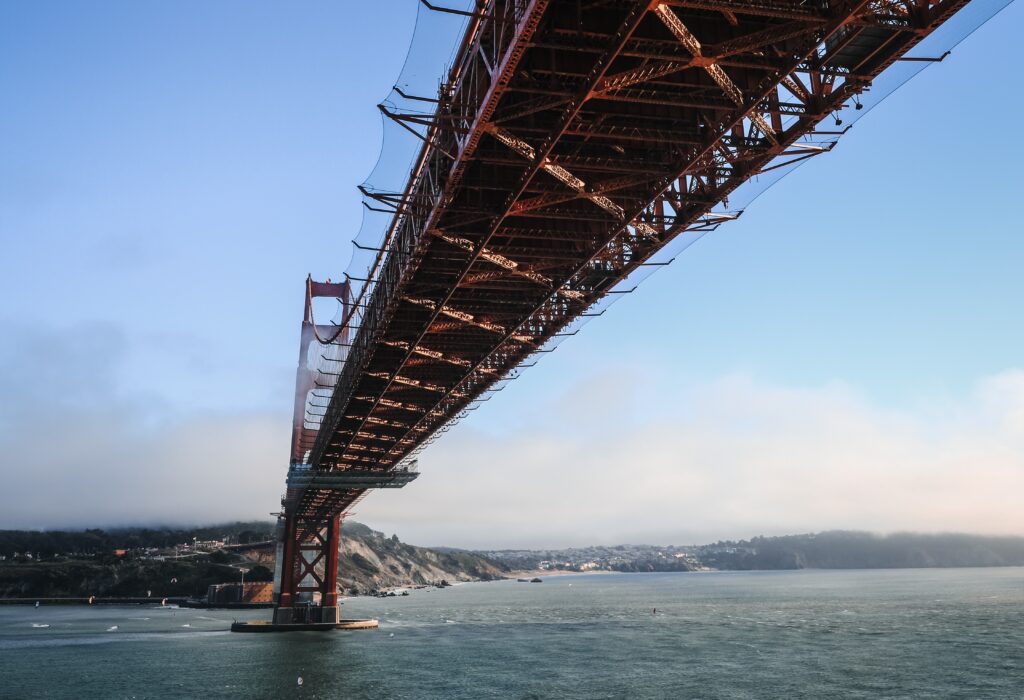In June 2025, the International Bridge Conference (IBC) was held in Pittsburgh where bridge owners and engineers, senior policy makers, government officials, bridge designers, and construction executives come together to address key challenges facing the industry.
The event included speakers and presentations, including RWDI’s own Erik Marble. As a specialist on the effects of wind on bridge design, Erik collaborated with colleagues to present their paper on bridge aerodynamics during retrofit operations.
We spoke to Erik to get the most important takeaways from his presentation.
Q: What is meant by the aerodynamic performance of cable supported bridges?
The aerodynamic performance of cable-supported bridges refers to how these structures interact with the wind; this typically focuses on their aerodynamic stability and wind loading. Because cable-supported bridges are typically long-span and inherently flexible, they are more susceptible to wind-induced effects such as flutter and vortex shedding.
Unlike shorter or more rigid bridges, their design cannot rely solely on standard approaches—each project tends to be unique and may present specific challenges that require tailored solutions. To accurately assess and mitigate these risks, wind tunnel testing becomes essential, providing detailed insights into how the structure will behave under various wind conditions and ensuring safe and reliable performance during both normal operation and retrofit activities.

Q: What are some examples of retrofit projects and the temporary structures they use?
Retrofit projects on cable-supported bridges cover a wide range of maintenance and upgrade activities aimed at extending the life and improving the safety of these structures. Some common types of retrofit projects include:
- Seismic upgrades to enhance earthquake resistance
- Truss member replacements to address structural wear
- Painting to protect against corrosion
- Fence installations for safety
- Deck replacements to renew the driving surface
- Cable dehumidification systems to prevent cable corrosion
To carry out these works, various temporary structures are often used to provide access, protection, or containment. These temporary works can include
- Platforms that allow workers to safely reach difficult areas
- Fences installed for safety or security
- Scaffolding to support personnel and equipment
- Tarping to protect surfaces or contain dust
- Debris screens to prevent falling materials
- Barriers to manage traffic or isolate work zones
While necessary for construction and maintenance, these temporary additions can change the aerodynamics of the bridge and must be carefully considered to avoid creating wind-related issues.
Q: Why is it important to consider a bridge’s aerodynamic performance during retrofits?
It’s important to think about how wind affects a bridge not just when it’s first built, but also during retrofit or maintenance work. Cable-supported bridges are long and flexible, which already makes them more sensitive to wind. When temporary materials like tarps, scaffolding, or platforms are added during retrofits, they can change the shape of the bridge and how wind flows around the deck—sometimes in ways that make the bridge less stable. These effects, when overlooked, can lead to serious problems, such as vibrations that are uncomfortable to bridge users or increased wind loading.
When temporary materials like tarps, scaffolding, or platforms are added during retrofits, they can change the shape of the bridge and how wind flows around the deck—sometimes in ways that make the bridge less stable.
There have been recent examples where this has occurred, showing that the risk is very real. That’s why we focused on developing a strategy to help engineers and contractors plan for wind effects during retrofits, to ensure bridges remain safe and stable throughout the entire process. Our strategy for providing an aerodynamically viable plan for construction sequencing combines experimental wind tunnel measurements with numerical simulations to optimize the layout of tarping, enclosures, or platforms on the bridge.

Q: What is the number one takeaway from your paper?
Don’t forget about wind during bridge maintenance!
A few years ago, there was a widely shared video showing unusual bridge movements during maintenance, which caused a lot of public concern and even went viral on social media. The event highlighted how important it is to carefully consider wind interactions with any temporary additions on a bridge. Ignoring these factors can lead to serious public relations problems, as bridge users can become alarmed by unexpected vibrations or movements—even if the structure itself remains safe.
Our goal is to raise awareness so that engineers and contractors approach maintenance with a full understanding of aerodynamic risks, avoiding both technical problems, unnecessary public worry, and a PR disaster.
We also plan safe and efficient ways to upgrade bridges by testing how wind affects them using both wind tunnel experiments and computer simulations to guide the construction process.
